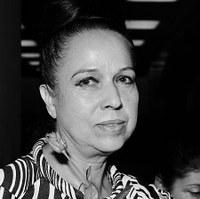Cidade do México (México), 1917 – 2000
By Valerio Césio
Mexican dancer and choreographer Amalia Hernández began dancing at the age of eight, taking private lessons at home with master Hipólito Sybine (first dancer of Anna Pavlova’s Ballet) and teacher Nelsy Dambré (member of the Paris Opera Ballet). Later, she studied with the Spanish dancer “La Argentinita” (Encarnación Lopez), completing her training with the Campobello sisters, Miguel Covarrubias, and theater director Seki Sano.
At the Mexican Dance Academy (founded in 1947), she participated as a dancer, teacher, and choreographer. At that time, she had already created the choreographies Sonatas and Sinfonía india, with music by Carlos Chavez, and participated in Waldeen’s Modern Ballet, where she stood out for her performance as a dancer in the piece La coronela in 1940.
The dances of different regions of Mexico became her passion, and in 1952, she formed her own company, Ballet Moderno de México, which debuted with eight dancers and soon expanded to twenty members, thanks to the success of the television program Função de Gala, in which she participated for 67 consecutive weekly editions, premiering a vast repertoire.
In 1958, she took her work to Cuba, Canada, and the United States, and in 1959, to the Pan American Games in Chicago. On that occasion, her company, now with fifty members, was renamed Ballet Folklórico de México and achieved notable success with the choreographies Los hijos del Sol, Sones antiguos de Michoacán, El cupidito, Fiesta veracruzana, Los quetzales, La danza del venado, and Navidad en Jalisco.
As a result of the success achieved, the Ballet was invited to perform weekly at the Palacio de Bellas Artes starting on October 11, 1959. From that time until the end of the 20th century, the Ballet Folklórico de Amalia Hernández (which for a time was also known as Ballet Folklórico de Bellas Artes) performed continuously, three times a week.
In 1961, the group received the first prize at the Theatre of Nations Festival in Paris and, in the following years, carried out extensive tours throughout the Americas, Europe, Africa, Asia, and Oceania.
Among the more than two hundred awards and recognitions the Ballet received are: the Medal of Peace (1963, Canada) and the Order of Arts and Letters (1964, France). In 1993, Amalia Hernández joined the National System of Art Creators of Mexico as an emeritus creator.



